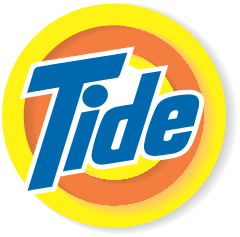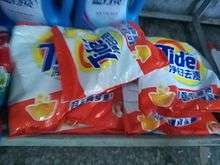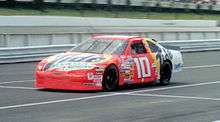Tide (brand)
 | |
| Laundry Detergent | |
| Product type | Heavy-duty synthetic detergent |
|---|---|
| Owner | Procter & Gamble |
| Country | United States |
| Introduced | 1946[1] |
| Related brands |
Ace (Latin America) Alo (Turkey) |
| Markets | United States, Canada, Europe, Latin America, India, Israel, Morocco, Philippines, Saudi Arabia, Turkey, Vietnam |
| Website | http://www.tide.com |

Tide (Alo, Vizir or Ace in some countries) is a laundry detergent manufactured by Procter & Gamble, introduced in 1946.[2]
Background
The household chore of doing the laundry began to change with the introduction of washing powders in the 1880s. These new laundry products were pulverized soap. New cleaning-product marketing successes, such as the 1890s introduction of the N. K. Fairbank Company's Gold Dust Washing Powder (which used a breakthrough hydrogenation process in its formulation),[3] and Hudson's heavily advertised product, Rinso,[4] proved that there was a ready market for better cleaning agents. Henkel & Cie's "self-activating" (or self bleaching) cleaner, Persil; (introduced in 1907);[5] the early synthetic detergent, BASF's Fewa (introduced in 1932); and Procter & Gamble's 1933 totally synthetic creation, Dreft (marketed for use on infant-wear)[6] —all indicated significant advances in the laundry cleaning product market.
The detergent business was further revolutionized with the discovery of the alkylbenzene sulfonates, which, when combined with the use of chemical "builders", made machine washing with hard water possible.[6] This presented Procter and Gamble with the opportunity to create a product such as Tide.
History

The original Tide laundry detergent was a synthetic designed specifically for heavy-duty, machine cleaning (an advance over the milder cleaning capabilities of FeWA and Dreft). Tide was first introduced in U.S. test markets in 1946 as the world's first heavy-duty detergent, with nationwide distribution accomplished in 1949. Tide claimed it was "America's Washday Favorite." Authority was quickly gained in the U.S. detergent market, dwarfing the sales of Ivory Snow; and accelerating the demise of two of its main competing products, Rinso and Gold Dust Washing Powder, both then Lever Brothers brands. These other brands came in the more familiar soap-powder and soap-flake forms. Tide, however, came shaped as a white powdered bead. The line was expanded to include an orange-tinted clear liquid form in 1984. Today, most formulations of liquid Tide, both concentrated and regular, are dark blue, with the exception of "Tide Free", which is clear. Each year, Tide researchers duplicate the mineral content of water from all parts of the United States and wash 50,000 loads of laundry to test Tide detergent’s consistency and performance.
In 2006, the development of Tide was designated an ACS National Historic Chemical Landmark in recognition of its significance as the first heavy-duty synthetic detergent.[7]
As of January 2013 Tide has more than 30% of the liquid-detergent market, with more than twice as much in sales as the second most-popular brand Gain, although it costs about 50% more than the average liquid detergent.
In some areas, Tide has become such a hot commodity item, that criminals steal it from stores to resell. Police call the detergent "liquid gold" on the black market and it's been known to be traded or sold for illegal drugs.[8][9]
Brand
In a 2009 survey, consumers ranked Tide among the three brands they would be least likely to give up during the Great Recession.[8] The Tide trademark is an easily recognized, distinctive orange-and-yellow bulls-eye. This original logo was designed by Donald Deskey, an architect and famous industrial designer. The logo was slightly modified for the product's fiftieth anniversary in 1996, and remains in use today.
Tide was the first product to be nationally packaged using Day-Glo colors—strikingly eye-catching when first introduced in 1959.[10]
The Tide brand is on at least six powders and liquid detergents in the United States.
Product line
Tide is marketed under various sub-brands, such as 2x Ultra Tide.[11] In the late 1960s and early 1970s, it was branded as Tide XK (the XK standing for Xtra Kleaning), but it was rebranded simply as Tide later.
An addition to the Tide family, Tide Coldwater was formulated to remove stains while saving energy because it does not require hot or even warm water.[11] Tide Free is marketed as being free from dyes or perfumes. Tide-To-Go is a product packaged in a pen-like format and intended to remove small stains on the spot, without further laundering.[11]
In Puerto Rico[12] and elsewhere in Latin America, the Tide formula is marketed under the name Ace (except in Ecuador and Panama, where it is sold under the same Tide brand as is in current use in the U.S.) In Turkey, Tide is branded as Alo. In Poland it is sold as Vizir.
Tide is sold in the UK as Daz Go-Pods; they have the marking "Daz/Vizir/Tide" on the back and bear the same distinctive design.
Since 2012, Tide has sold laundry detergent pods, making an estimated 15% of market sales.[13][14]
Sponsorships

Tide has also sponsored a few things like NASCAR stock cars, notably as the "Tide Ride". Darrell Waltrip drove the #17 Tide-sponsored Chevy for Hendrick Motorsports. The relationship lasted from 1987 to 1990 and won the 1989 Daytona 500 along the way. Waltrip left the team to form his own team. Tide then sponsored Ricky Rudd in the #5 car after Levi Garrett left Hendrick. Rudd drove for Hendrick until 1993, when he left the racing team, also to form his own team and taking the Tide sponsorship. Rudd Performance Motorsports ran from 1994-1999 and won the 4th Brickyard 400 in 1997. After Rudd became winless in his first time in 17 seasons, Tide left Rudd after being lured by Calvin Well's new team PPI Motorsports. The new team's number was 32, which was a combination of 17, 5, and 10 added all up. Scott Pruett was the first driver but after DNQing 6 times and no Top 10's. Ricky Craven took over in 2001 and responded with a win at Martinsville Speedway. He went winless in 2002, but one year later, he won the closest race in NASCAR history at Darlington in the Carolina Dodge Dealers 400, rubbing with Kurt Busch for laps and with a margin-of-victory of 0.002. It is tied for the closest finish in Cup Series history. After no Top 10's halfway through the 2004 season, Craven left PPI and was replaced by Bobby Hamilton, Jr. for 2004 and 2005. Travis Kvapil ran for PPI in 2006 but with four DNQ's. Tide left the sport before it was going to sponsor one of Well's proposed Toyota teams in 2007. Tide was on Kevin Harvick's truck a few times, but Kroger was promoting the car with it. Tide made its Cup series return in September 2016, when it sponsored Matt Kenseth's No. 20 car for a Darlington tribute scheme. Tide extended their sponsorship to Joe Gibbs Racing to three races in 2017.
References
- ↑ http://www.pg.com/Heritage/branding.php
- ↑ Davis, Dyer; et al. (May 1, 2004). Rising Tide: Lessons from 165 Years of Brand Building at Procter and Gamble. Harvard Business Press. p. 426. Retrieved 2013-05-07.
- ↑ The Holland Evening Sentinel; Holland, MI; Newspaper James F. Boyce, Sr. Obituary Article, Jun 4, 1935
- ↑ "History of soap". Archived from the original on 2010-11-16. Retrieved 2010-11-16.
- ↑ "100 Years of Persil". Henkel. Retrieved 2012-11-18.
- 1 2 Eduard Smulders, Wolfgang Rybinski, Eric Sung, Wilfried Rähse, Josef Steber, Frederike Wiebel, Anette Nordskog, "Laundry Detergents" in Ullmann’s Encyclopedia of Industrial Chemistry 2002, Wiley-VCH, Weinheim. doi:10.1002/14356007.a08_315.pub2
- ↑ "The Development of Tide Synthetic Detergent". National Historic Chemical Landmarks. American Chemical Society. Retrieved March 25, 2013.
- 1 2 Paynter, Ben (2013-01-06). "Suds for Drugs". New York. Retrieved January 7, 2013.
- ↑ Nestel, M.L. (March 12, 2012). "Grime Wave". The Daily.
- ↑ "DayGlo Fluorescent Pigments". National Historic Chemical Landmarks. American Chemical Society. Retrieved March 25, 2013.
- 1 2 3 "Tide Laundry Detergent And Fabric Care Products". Tide.com. Retrieved 2012-11-18.
- ↑ "The Clorox Company Puerto Rico, Plaintiff, Appellant, v. The Procter & Gamble Commercial Company, Defendant, Appellee.". United States Court of Appeals, For the First Circuit. October 3, 2000. Retrieved September 4, 2013.
- ↑ "Laundry detergent pods remain a health hazard". Consumer Reports. March 2013. Retrieved 11 November 2014.
- ↑ "Tide’s Answer To Slumping Sales? Use More Detergent Pods!". Consumerist. 2016-06-08. Retrieved 2016-11-12.
Further reading
- Leu, Chelsea (27 May 2016). "Here’s What’s Inside Those Magical Stain-Erasing Pens". Wired. Retrieved 28 May 2016.